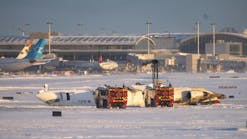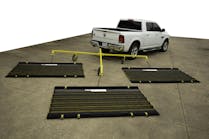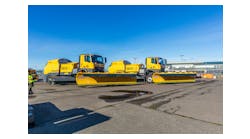Runway and Upgrade Work on Southeast Iowa Regional Airport in Burlington Nearing Completion
Oct. 25—The lights are shining bright at Southeast Iowa Regional Airport in Burlington.
Hundreds of new LED lights aluminate the recently completed 6,100-foot-long Runway 18/36 — so called for its compass bearing of 180 degrees north and 360 degrees south — at the airport as part of a $12 million project.
"It is a great asset for southeast Iowa to have an airport with this kind of facility," said Charlie Walsh Sr., chairperson of the Airport Authority Board. "It makes other communities envious."
The project has been in the works for the past six or seven years, according to Airport Director Mary Beaird. The airport was awarded a $10.95 million federal grant in Federal Fiscal Year 2020 for the $12.16 million project. The community was responsible for 10% of the cost.
The airport, Des Moines County and the cities of Burlington and West Burlington contributed the matching funds, with Burlington contributing $669,121, Des Moines County spending $116,981 and West Burlington kicking in $107,059. The Airport Authority contributed the remaining about $320,000.
"We are very proud and thankful for the community to help pay for it," said Dan Wiedemeier, Airport Authority board member.
Manatt's Inc, of Brooklyn, Iowa, is the primary contractor and McClure Engineering, Ankeny, are the airport engineering consultants. The first two phases of the project completed the new primary runway 18/36 with a length of 6,100 feet at 100 feet wide. Phase 3 work continues with the intersection of runways 18/36 and 12/30 and includes dirt work, drainage, concrete pouring, signage and lights.
The runways equipped with a pilot-controlled lighting system through a key-up process from the pilots mics. There are high, medium and low settings for the lights.
"It brightens the runway and is a much-needed improvement for the pilots," said Beaird.
The project was needed due to the age of the runway. The surface first was completed in 1944. It was resurfaced in 2005 but was beginning to deteriorate. Part of that deterioration was due to sub-surface degrading over the years.
An important part of the project was to bring the drainage in line with airport specifications. This involved a deep dig on the west side of the airport to provide new underground drainage pipes to keep runoff drained properly.
"It is important to keep the ground dry to deter waterfowl from the area," said Beaird.
The work on the runway surface was simply a safety factor to remove foreign object debris caused by concrete breaking up that could damage aircraft.
"The old runway was in rough shape and harder to maintain," Ethan Gerst, airport operations specialist, told The Hawk Eye as he drove his truck north down the runway. "This surface is smooth. It's gonna be a lot nicer to maintain for winter operations."
The new runway was reduced from 150 to 100 feet wide and shortened from 6,700 to 6,100 feet. According to Beaird, the extra 600 feet was only a buffer for landings and doesn't impact aircraft using the airport.
"The size was determined by the FAA who looks at the specs of the aircraft using the runway over a period of time," said Beaird. "The specs fit for a Gulfstream V aircraft."
Phase 3 work is underway and is expected to complete in December. The final phase will finish the intersection and taxiway at the north end of the airport. The 18/36 runway is divided in two directions, with 18 at the north and 36 at the south end. The 12/30 runway runs in the opposite direction, with 12 at the west and 30 at the east end.
Crews are completing dirt work to raise the north end of 18/36 and east end of 12/30 at a 5% grade to improve line of sight issues for pilots. Workers then will complete the concrete work for the intersection of the two runways.
"It's beautiful, outstanding," said Walsh. "A great asset for the community."
___
(c)2020 The Hawk Eye (Burlington, Iowa)
Visit The Hawk Eye (Burlington, Iowa) at www.thehawkeye.com
Distributed by Tribune Content Agency, LLC.




